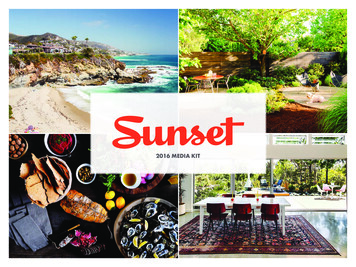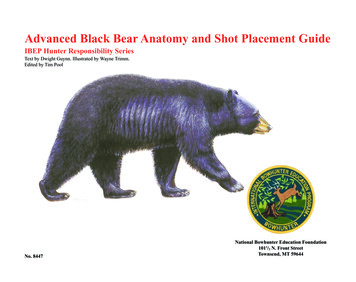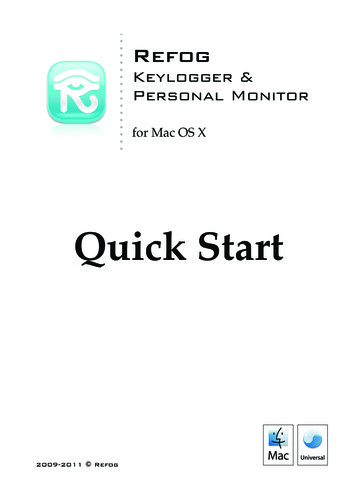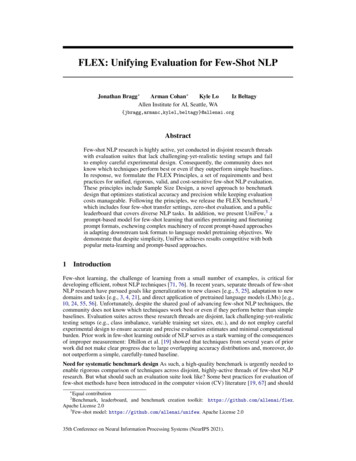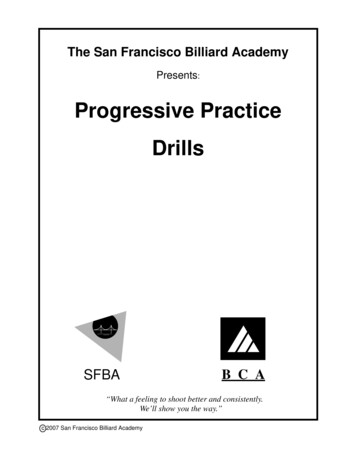
Transcription
Create the Perfect Sunset ShotPage 1Create the PerfectSunset ShotCapturing the beauty of sunset (or sunrise) is sometimes alittle trickier than it appears. Because of the wide range of light,it's difficult for your digital camera to accurately record the detailsof the foreground and the background. The easiest way to get theperfect sunset photo is to take two photos — one exposed forthe darker foreground and one properly exposed for the lighterbackground, and combine them using Paint Shop Pro. For thistutorial, download the sample images provided and follow along.Once you understand the concepts of combining photos, you'llbe able to use the skills you learn here on your sunset photos.What you’ll need: Sample Sunset foreground image Sample Sunset background image Jasc Paint Shop Pro When you complete this tutorialyou’ll be able to: Copy a photoPaste a photo as a new layer on top of another photoRename layersCopy a layerTransform a photo into a Mask LayerModify a Mask LayerCombine two photos so that the best of both shine throughNote: The two sample images used in this tutorial were taken with a digitalcamera attached to a tripod. The intent was to take two identical photos usingdifferent exposure settings. The foreground photo was taken using an exposuresetting of 1.0 (overexposed) and the background photo was taking using asetting of –1.0 (underexposed). Most digital cameras allow you to manuallyselect an exposure setting. Refer to your camera's user guide for moreinformation on Exposure Bracketing.www.jasc.com
Create the Perfect Sunset ShotOpen the Sample Photos1.Choose Start Programs Jasc Software Jasc Paint Shop Proor double click the Paint Shop Pro Icon on your desktop to open Paint Shop Pro.2.Choose File Browse or click the Browse button on the Standard toolbar to open the ImageBrowser. Use the Image Browser to find the sample photos you downloaded with this tutorial.3.Paint Shop Pro's Image Browser works like Windows Explorer. On the left, navigate to the foldercontaining the photo you want to use. On the right, double-click Sunset foreground and then theSunset background photos to open them.Tip: After opening both photos, you may want to reduce their zoom level to 50 percent or less to freeup more screen area for your work.Copy the Foreground and Paste it into theBackground4.Before you get started you'll want to make sure the Layer palette is displayed.Choose View Palettes Layers.Page 2
Create the Perfect Sunset Shot5.Click the Sunset foregroundphoto to make sure it's theactive image, and then copy itto the clipboard by pressing Ctrl C (or choose Edit Copy).6.Now click the Sunset background photo to make it the active image and then press Ctrl L(or choose Edit Paste Paste as New Layer). This pastes the Sunset foreground photo on topof the Sunset background as a separate layer (called Raster 1).Tip: When you need to copy an entire image to the clipboard be careful when using Ctrl A(or Selections Select All) if the magnification level is such that part of the image is off screen. Ctrl A will only copy the visible portion of the image, which may not be what you intended.Using Ctrl C will copy the entire image every time.Rename Layers7.In the Layer palette, right click the Raster 1layer and choose Rename. Enter the wordForeground and press Enter, this will makeit easier to keep track of what each layercontains.Page 3
Create the Perfect Sunset Shot8.Now, in the Layer palette, right click theForeground layer and choose Duplicate(or click the Duplicate button at the topof the Layer palette). This creates a newlayer called Copy of Foreground.9.Rename the Copy of Foreground using the same method in Step 7, only this time call the layerMask Source.Tip: Use new layers to make edits. This prevents the original layer (Background layer) from being altered.Convert Mask Source to Greyscale10. Now we're going to adjust the saturation level of the Mask layer, essentially turning it into agreyscale image needed for the mask. Choose Adjust Hue and Saturation Hue/Saturation/Lightness, or press Shift H.Page 4
Create the Perfect Sunset Shot11. On the Hue/Saturation/Lightness dialog, leave the Hue andLightness values at 0, but set the Saturation to –100.Click OK to apply the settings.Convert Mask Source to Black and White12. With the Mask Source layer still active (click it in the Layer palette to be sure), we'll turn thegreyscale image into a black and white. The goal is to create an all white background and an allblack foreground. Choose Adjust Brightness and Contrast Brightness/Contrast or press Shift B.Page 5
Create the Perfect Sunset Shot13. In the Brightness/Contrast dialog, setthe Brightness value to –10 and set theContrast to 60. These settings work wellfor this image, but you can experimentwith the adjustments if you desire. Click OKto apply these settings to your Mask source layer.Note: Masks are greyscale images appliedto layers. A Mask layer's black pixels willcompletely hide underlying pixels, while thewhite pixels reveal underlying pixels. Dependingon the lightness their lightness level, pixels thatare varying shades of grey will partially hide orreveal the underlying pixels.Create a Mask14. In the Layer palette, click the Foreground layer to make it active.15. Now choose Layers New Mask Layer From Image.Page 6
Create the Perfect Sunset Shot16. In the Add Mask from Image dialog, Sunset background is already in the Source Window field —don't change this. In the middle section of this dialog, choose the Source Luminance option (thisuses the luminance/lightness value of the mask layer pixels to determine what hides and whatshows through). At the bottom of the dialog, mark the Invert mask data box (this will reverse thetransparency of the mask data to hide the undesired part of each image and reveal the desired part).Click OK to apply your settings. Your layer palette should look similar to the one shown here.View the Results17. In the Layer palette, click the layer named Mask Source and then click the Visibility Toggle(the eye icon) so the red X appears over it. Turning off this layer reveals the overall image, whichbecause of the mask layer seamlessly combines the desired background with the desiredforeground.Page 7
Create the Perfect Sunset ShotSave Your New Image18. Now that you're done, you save your image. Choose File Save As. In the File Name field giveyour photo a new title. In the Save as type field save it as Paint Shop Pro Image to retain the layerinformation, or you can save it as a jpeg if you want to e-mail it to friends and family and showthem what you've accomplished with Paint Shop Pro.Next Steps:By practicing the techniques you've learned here, as well as experimenting withother Masking techniques, you'll quickly realize the power this feature holds. Youcan use masking to combine all kinds of photos to create sophisticated collages.Refer to the Paint Shop Pro User Guide for more detailed information.If you'd like to see the Mask feature in action, watch the Photo Collage movie inthe Paint Shop Pro 8 Product Tour (in the application, choose Help ProductTour), and in the Photo Features section of the Tour, choose the Photo Collagemovie.Page 8
Create the Perfect Sunset Shot Page 3 5. Click the Sunset foreground photo to make sure it's the active image, and then copy it to the clipboard by pressing Ctrl C (or choose Edit Copy). 6. Now click the Sunset background photo to make it the active image and then press Ctrl L (or choose Edit Paste Paste as New Layer).This pastes the Sunset foregroundphoto on top
